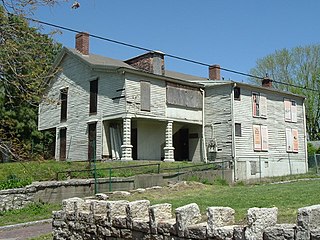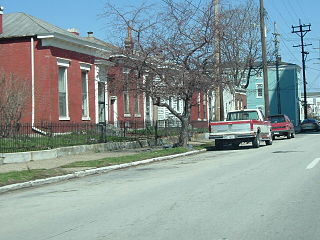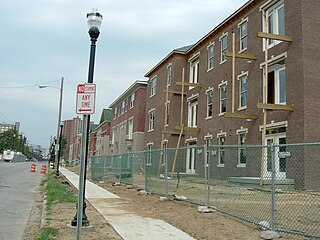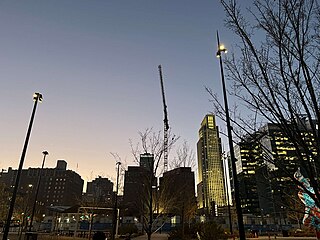
Louisville is the most populous city in the Commonwealth of Kentucky, sixth-most populous city in the Southeast, and the 27th-most-populous city in the United States. By land area, it is the country's 24th-largest city, although by population density, it is the 265th most dense city. Louisville is the historical county seat and, since 2003, the nominal seat of Jefferson County, on the Indiana border.

The Speed Art Museum, originally known as the J.B. Speed Memorial Museum, now colloquially referred to as the Speed by locals, is the oldest and largest art museum in Kentucky. It was established in 1927 in Louisville, Kentucky, on Third Street next to the University of Louisville Belknap campus. It receives around 180,000 visits annually.

The Original Highlands is a historic neighborhood in the Highlands area of Louisville, Kentucky, United States.

Portland is a historic district, neighborhood and former independent town northwest of downtown Louisville, Kentucky. It is situated along a bend of the Ohio River just below the Falls of the Ohio National Wildlife Conservation Area, where the river curves to the north and then to the south, thus placing Portland at the northern tip of urban Louisville. In its early days it was the largest of the six major settlements at the falls, the others being Shippingport and Louisville in Kentucky and New Albany, Clarksville, and Jeffersonville on the Indiana side. Its modern boundaries are the Ohio River along the northwest, north, and northeast, 10th Street at the far east, Market Street on the south, and the Shawnee Golf Course at the far west.

Russell is a neighborhood immediately west of downtown Louisville, Kentucky, U.S.. It is nicknamed "Louisville's Harlem". It was named for renowned African American educator and Bloomfield, Kentucky native, Harvey Clarence Russell Sr. Its boundaries are West Market Street, 9th Street, West Broadway and I-264.

Downtown Louisville is the largest central business district in the Commonwealth of Kentucky and the urban hub of the Louisville, Kentucky Metropolitan Area. Its boundaries are the Ohio River to the north, Hancock Street to the east, York and Jacob Streets to the south, and 9th Street to the west. As of 2015, the population of downtown Louisville was 4,700, although this does not include directly surrounding areas such as Old Louisville, Butchertown, NuLu, and Phoenix Hill.

Butchertown is a neighborhood just east of downtown Louisville, Kentucky, United States, bounded by I-65, Main Street, I-71, Beargrass Creek and Mellwood Avenue.

Smoketown is a neighborhood one mile (1.6 km) southeast of downtown Louisville, Kentucky. Smoketown has been a historically black neighborhood since the Civil War. It is the only neighborhood in the city that has had such a continuous presence. Smoketown is bounded by Broadway, CSX railroad tracks, Kentucky Street, and I-65.

Shelby Park is a neighborhood two miles southeast of downtown Louisville, Kentucky, USA, named after Kentucky's first governor, Isaac Shelby. Shelby Park has always been considered a working-class neighborhood. It was first populated by German immigrants in the early 1900s. By the 1950s, the neighborhood was majority African-American. Today, Shelby Park is a blend of ethnic and economic diversity. People from all walks of life co-exist in a vibrant, art-filled community.

This is a list of official neighborhoods in Louisville, Kentucky. Like many older American cities, Louisville has well-defined neighborhoods, many with well over a century of history as a neighborhood.

Phoenix Hill is a neighborhood of Louisville, Kentucky just east of Downtown. Its boundaries are Market Street to the North, Preston Street to the West, Broadway to the South, and Baxter Avenue to the East. The Phoenix Hill neighborhood, settled before 1850 by German immigrants, is now a rich tapestry of people and a diverse mix of business, industry and residences.

Paddy's Markets is a commercial enterprise that has two large markets in Sydney, New South Wales, Australia. Paddy's Markets are located in Haymarket and Flemington and specialise in the sale of fruit, vegetables, fish, clothes and giftware. Both markets are operated by Sydney Markets Limited, along with the rest of Sydney Markets located at Flemington.
John Gill Holland Jr. is an American entrepreneur and film producer. He is the co-developer of The Green Building in Louisville, Kentucky. In 2016 and 2017, Holland was voted Best Entrepreneur in Louisville's LeoWeekly Readers' Choice Awards. In 2017, Louisville Business First honored him with the Excellence in Leadership Award for his successful NuLu redevelopment in the East Market District and current efforts in the Portland neighborhood.

The Snead Building located at 815 W. Market St. is a multi-use facility housing two working glass studios : a Walk-In Workshop and tours by appointment.

The Haymarket referred to an outdoor farmers' market in Louisville, Kentucky. The market occupied the block between Jefferson, Liberty, Floyd and Brook streets. A small section extended south down Floyd Street. It was established in 1891 on the site of the city's earliest rail station, belonging to the Louisville and Frankfort Railroad. The site had been cleared after the station relocated to First Street in 1881.

Louisville, Kentucky is home to numerous structures that are noteworthy due to their architectural characteristics or historic associations, the most noteworthy being the Old Louisville neighborhood, the third largest historic preservation district in the United States. The city also boasts the postmodern Humana Building and an expanding Waterfront Park which has served to remove the former industrial appearance of the riverfront.

Downtown Omaha is the central business, government and social core of the Omaha–Council Bluffs metropolitan area, U.S. state of Nebraska. The boundaries are Omaha's 20th Street on the west to the Missouri River on the east and the centerline of Leavenworth Street on the south to the centerline of Chicago Street on the north, also including the CHI Health Center Omaha. Downtown sits on the Missouri River, with commanding views from the tallest skyscrapers.
The Green Building is a building located in the East Market District (NuLu) of Louisville, Kentucky. It is Louisville's first commercial Platinum LEED certified building, and Kentucky's first Platinum LEED adaptive reuse structure. The building, designed by Los Angeles architecture firm (fer) studio, was awarded Platinum certification in 2010. Design principals, Doug Pierson and Chris Mercier, are both former senior project architects with Frank Gehry's Los Angeles office, Gehry Partners LLP.
The Clarksdale Housing Complex was a housing project located in Louisville, Kentucky, directly east of downtown in the Phoenix Hill neighborhood.

Haymarket in Boston is an open-air market on Blackstone, Hanover, and North Streets, next to the Rose Fitzgerald Kennedy Greenway between the North End and Government Center.
















